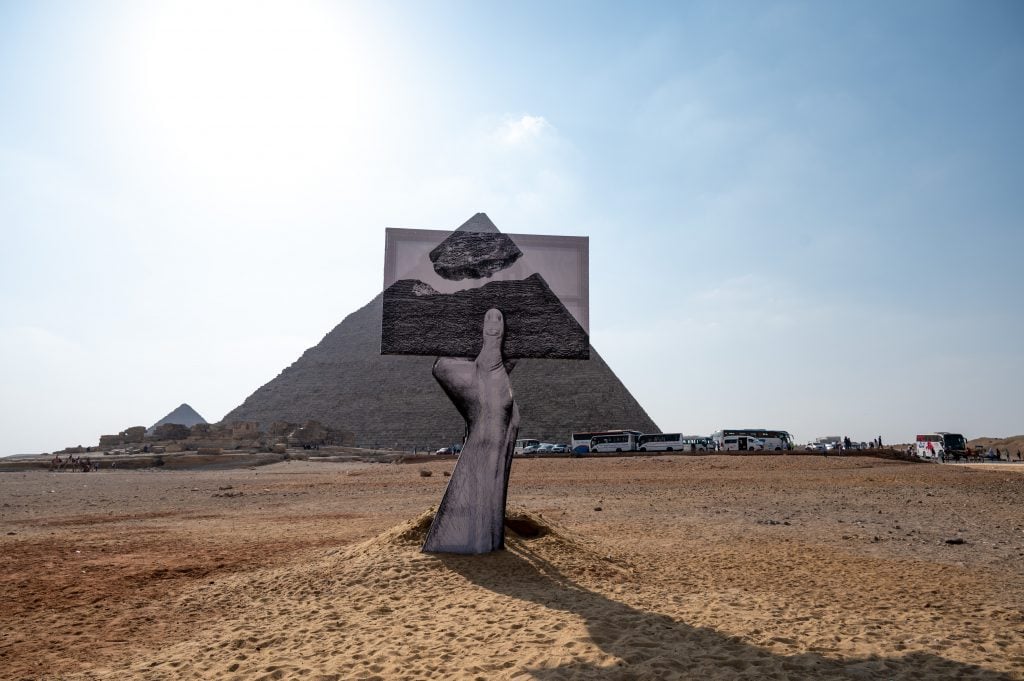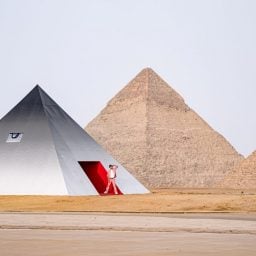Nadine Abdel Ghaffar, founder and director of Art d’Egypte, had good intentions when she launched an itinerant art exhibition of public art commissions in downtown Cairo in 2017.
Calling the show “a fusion between heritage and contemporary art and the contemporary artist who is in dialogue with either a heritage site or a historical monument, sculpture, or artifacts,” Ghaffar said Art D’Égypte, which opens its fifth edition on Thursday, October 27, was always meant to “generate awareness” about Egypt’s key heritage sites to ensure their preservation. Its first exhibition inside the Egyptian Museum in the capital eventually moved to the Giza pyramids in 2021, where it will have its upcoming edition this year.
Finally, after years of quiet, the international art community paid attention to Egypt. Back when it launched, little was being reported on Egypt’s contemporary art scene due to security concerns amid a government crackdown on any form of dissent, which continues to this day.
At the same time, Art D’Égypte has come under increasing scrutiny from members of the Egyptian art scene who say that the event leaves out crucial aspects of Cairo’s present contemporary art scene, making it seem, as one artist who spoke anonymously put it, that the “only thing happening in the country is Art D’Égypte, which simply is not true.” Last year, the Instagram profile @fartdegypte with the tagline “Leave the pyramids alone” was created by anonymous members of the local art community.
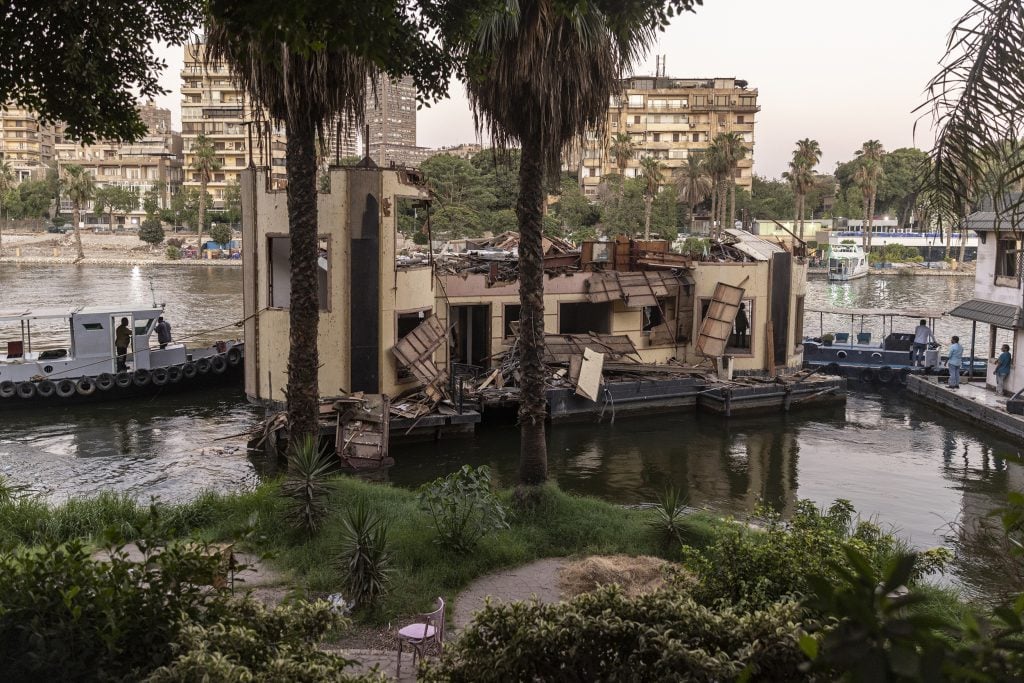
Houseboats of Cairo, Egypt taken on June 27, 2022. (Photo by Roger Anis/Egypt)
The pain is understandable: Cairo’s once thriving contemporary art scene has shrunk considerably over the last decade due to dwindling resources and state-led institutional closures. It survives, dangling by a thread.
Artists’ working spaces, old historic buildings, including Cairo’s historic houseboats on the Nile, are being demolished and threatened with rapid state-sanctioned gentrification, in line with the government’s plan to modernize and monetize Egypt’s capital by handing it over to the military or private developers. Entire historic neighborhoods are being bulldozed to build shiny high-rises while once revered houseboats are being replaced with floating restaurants to attract foreign visitors and investment.
“They want to change the character of the city; if you change its character, you are changing its soul,” said painter Mohammad Abla. The fate of his studio on Qursaya, an island on the Nile, remains uncertain. In 2007, the Egyptian government tried to sell it to investors to build modern high rises on it. Citizens, including Abla, protested and in 2010 the sale was stopped. But as of February 2022, Egyptian president Abdel Fattah El-Sisi handed over ownership of 37 islands in the Nile to the Egyptian army, including Qursaya, and residents say they fear what the future may bring.
“They want to turn Cairo into another Dubai,” added Abla. With large swathes of the city’s historic areas in the fray, and with Egyptian creatives feeling increasingly neglected, many cry to be heard, asking: What will be left of us?
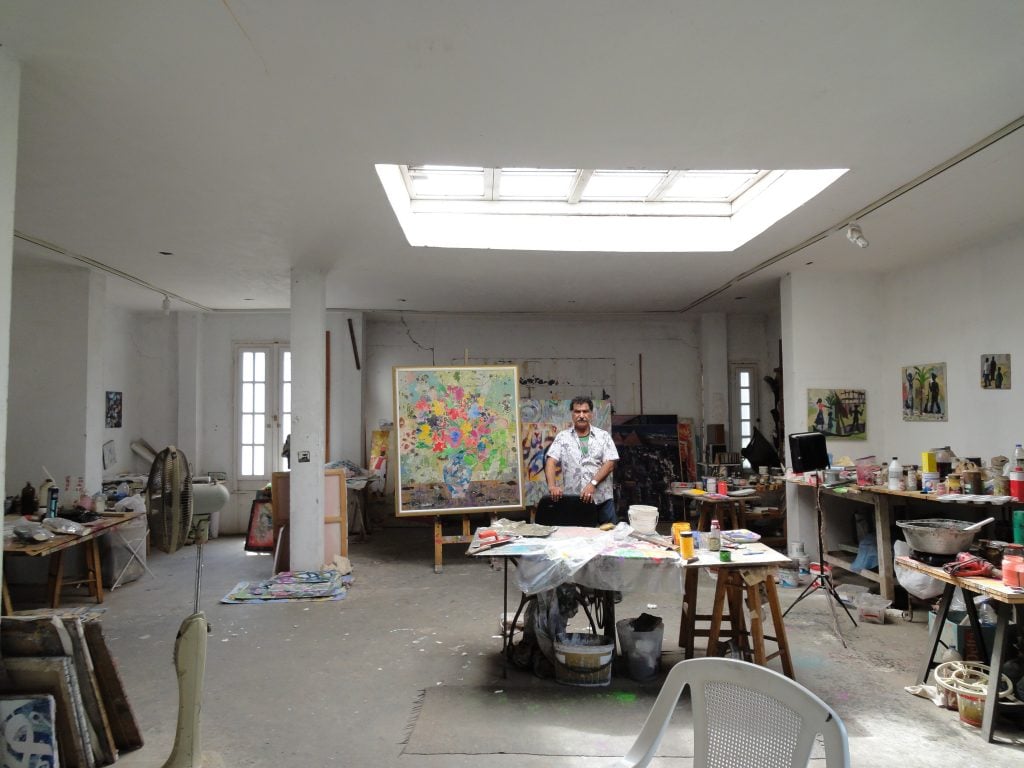
Mohammed Abla in his studio. Credit: Noura Simoni-Abla
Striving for Visibility
From the beginning, Art D’Égypte had a mission to showcase contemporary international and Egyptian art inside renowned monuments of ancient and modern Egyptian heritage and culture, and it has continued to do so through yearly exhibitions held under the auspices of the Egyptian Ministry of Antiquities. The exhibition platform’s head, Ghaffar, says Art D’Égypte’s core mission is “to democratize art” and that its exhibitions in public spaces are “open for everyone for free;” its a well-working model with last year’s show drawing 500,000 visitors from Egypt and abroad.
After its 2021 show presented works by predominantly international artists—including street artist JR, Italian sculptor Lorenzo Quinn, Saudi artist Sultan bin Fahad, and just two Egyptian artists, Moataz Nasr and Sherin Guirguis—this year’s edition focuses more on the Middle East and Africa. Artists Mohammed Al Faraj from Saudi Arabia, French Tunisian eL Seed, Ahmed Karaly from Egypt, and Cameroonian Pascale Marthine Tayou are among the 12 commissions. Called “Forever is Now II,” it will be held at the pyramids for the second time in a row.
This year Art D’Égypte is also hosting the second edition of the Cairo International Art District, an exhibition showcasing 120 artists, out of which 100 are Egyptian and 15 are international, demonstrating, Ghaffar emphasizes, how the of the organization focus is on Egypt.
Yet a more regionally focused artist list has not totally restored the local art scene’s confidence in the event, who say it still isn’t enough given the dire circumstances in the art scene at large. “My problem with Art D’Égypte is that it erases our history,” said the anonymous artist from Cairo. “The art scene has collapsed here. A lot of young artists are struggling, especially after Covid-19 and under the economic challenges in Egypt, to work and to show their work,” they added.
Institutions in the private sector such as Gypsum Gallery, Medrar, SOMA Art Gallery, Contemporary Image Collective, and Tintera Art, a photographic consultancy with a gallery space in Zamalek, are still standing as are notable and young Egyptian artists who continue to keep studio spaces in Cairo. But artists’ ways of living and working are imperiled.
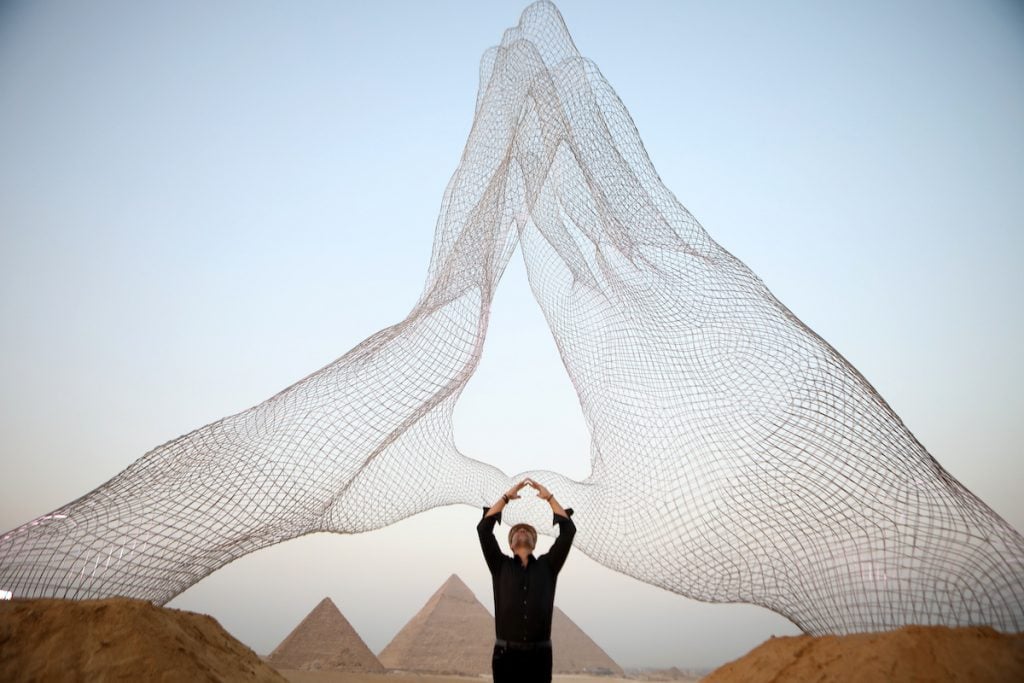
Italian artist Lorenzo Quinn poses under his installation, entitled Together, facing the pyramids for Art D’Égypte 2021. Credit: Ammar Abd Rabbo/Art D’Egypte
What Remains
Some Egyptians say the government is only interested in safeguarding the nation’s ancient Egyptian heritage to which the Grand Egyptian Museum, scheduled to open next month in Giza, is dedicated. Billed as the world’s largest museum of Egyptian civilization, the 117-acre site, located in the Giza Plateau next to the pyramids, will be devoted entirely to Egyptology, featuring the 3,200-year-old statue of Ramses II among its 100,000 ancient artifacts.
Originally estimated to cost around $500 million, due in part to delays, it now has a final price tag of over $1 billion. While some praise it as an example of Egypt reclaiming its past, others lament it as another instance of the government’s preference to use its ancient Egypt to drive tourism, overlooking the country’s rich Islamic and modern eras.
Meanwhile, Egyptian heritage and culture is facing an unprecedented crisis as the city transforms. Shiny new areas like New Giza and Sheikh Zayed City are cropping up, areas where those who can afford it are moving to; these parts of town are more similar to the glitzy futuristic metropolises of Dubai and Doha than they are to the attractive historic areas of Old Cairo, or to the neighborhoods of Zamalek or Giza.
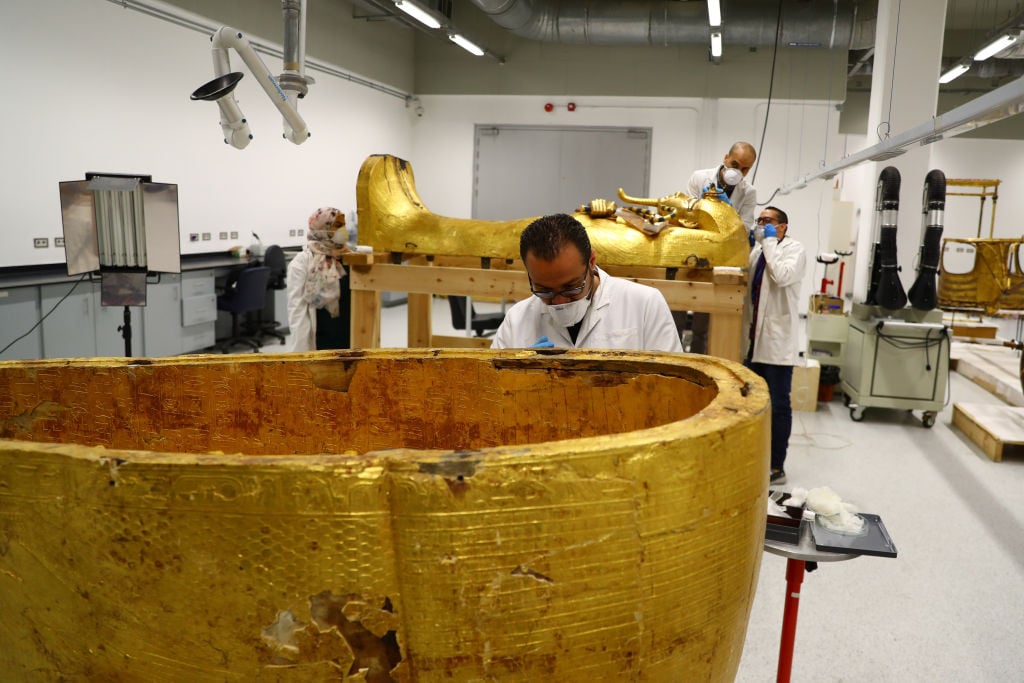
Archeologists working in the Grand Egyptian Museum in Giza, Egypt. Photo by Ahmed Gomaa/Xinhua via Getty) (Xinhua/ via Getty Images)
While Egyptian campaigners have long fought to keep old buildings standing amid the authoritarian regime of ex-army chief and current president Abdel Fattah el-Sisi, their efforts haven’t paid off; Egypt’s heritage continues to be under threat of extinction and along with it, the country’s identity, heritage, and collective memory.
One example is the 19th-century Islamic home of Bayt Madkour Pasha in Old Cairo, which is a specter of its former self. Once a residence of 43 families, it now looks akin to a bomb-shelled edifice, the result of years of neglect and destruction. In 2011, the Egyptian Antiquities Ministry refused to list it as an archeological site, stating that it was an insignificant building; it backed down in 2014, and ongoing demolition was stopped, but it remains endangered. Its entrance has been deliberately burnt down to enable the demolition process. Only a few families remain inside, but they don’t know how much time they have left there.
It is not the only remnant of Egypt’s more Islamic past. Much of the objects of that deeper history, a time period equivalent to Europe’s Medieval ages, have been subject to looting due to sectarian violence, terrorism, and theft, particularly since 2011 during the Arab Spring uprising. A walk around its ancient city center shows monuments in disarray, some completely closed due to lack of care.
A handful of private institutions working to restore and revive Egypt’s Islamic heritage are now fighting an upward battle. One is the Egyptian Heritage and Rescue Foundation founded in 2013 to promote and safeguard Egyptian and regional cultural heritage. Another, the Jameel House of Traditional Arts in Cairo, founded in 2009 by Art Jameel, a nonprofit arts organization supported by the Saudi Arabia-based Jameel family, admits 22 students per year on scholarships to learn traditional artisanal techniques with the aim of keeping such craftsmanship alive.
Yet these institutions are few and far between, just like the handful of contemporary art galleries and artists who struggle to be seen and heard amid the few glitzy art events in the North African capital that overshadow the country’s dire state of growing poverty and inflation.
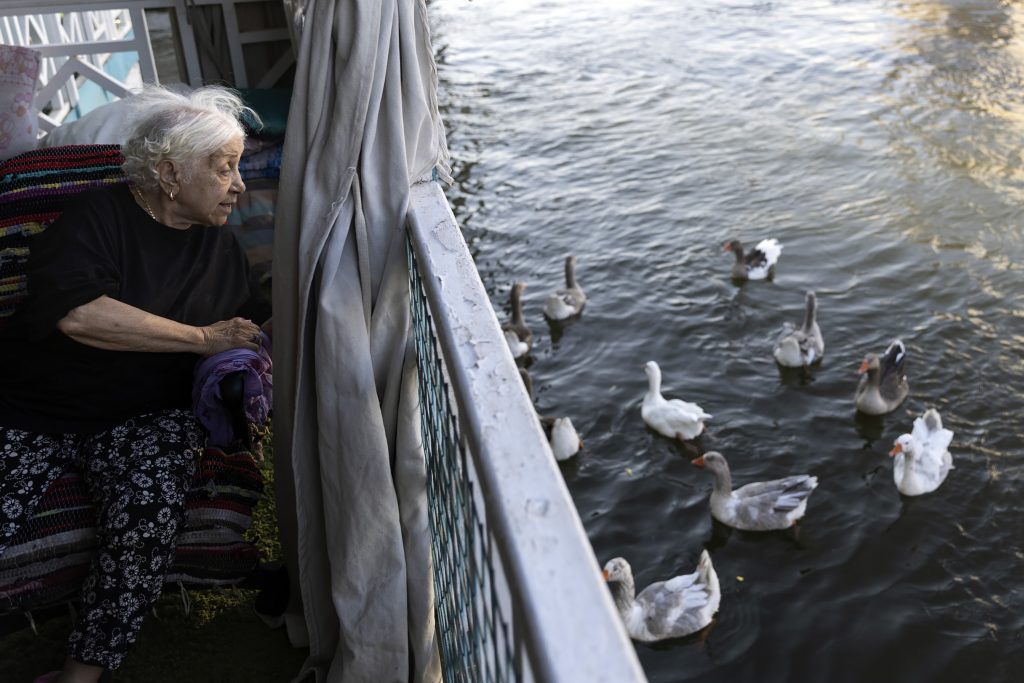
Houseboats of Cairo, Egypt. (Photo by Roger Anis/Egypt)
Cultural Erasure
Underneath all the new developments and public programming aimed at attracting foreign visitors and investors, as well as funded initiatives, the situation has hit new lows. In June this year, thirty of Cairo’s historic residential houseboats faced demolition, its residents evicted. These iconic homes long decorated the Nile River with their colorful décor and period architecture that dates back to Egypt’s Golden Age era from the late 19th- through mid-20th century. Since then, they have served as gathering places for Egyptian artists, intellectuals, and writers.
Egyptian author Ahdaf Soueif, who bought her houseboat at the end of 2012 was evicted earlier this year. She grieves the loss of her home. “Until a few years ago, I thought that whatever regime came in and whatever they did there was something at the core of the country that could always be retrieved and built on again. Now, I’m not sure,” Soueif told Artnet News. She was given a demand for nearly $50,000 in back licensing fees and fines on June 26 and a notice to evacuate by July 4. The law had been altered, and Soueif and 28 other home-owners were now deemed to have no right to their moorings.
“The regime does not value our heritage. Is the memory of Egypt—and the region—being lost or is it being destroyed?” she added. “We are seeing all the things that are special to Cairo, that give Cairo its character—1,000 years of continuous, layered history—being devalued and forced to squeeze itself into a Dubai mold.”
